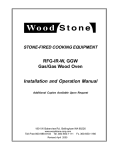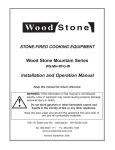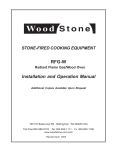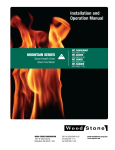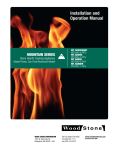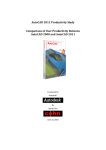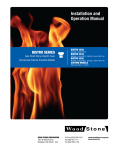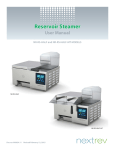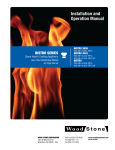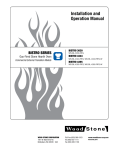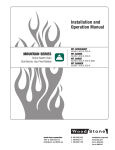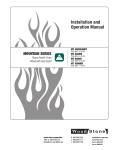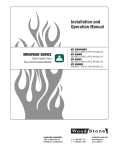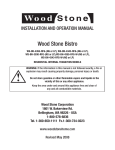Download Wood Stone GGW Operating instructions
Transcript
STONE-FIRED COOKING EQUIPMENT RFG-IR-W, GGW Gas/Gas Wood Oven Installation and Operation Manual Additional Copies Available Upon Request 1801 W. Bakerview Rd. Bellingham WA 98226 www.woodstone-corp.com Toll-Free 800-988-8103 Tel. 360-650-1111 Revised October 2007 Fx. 360-650-1166 Wood Stone WS-MS-(4,5,6,7)-RFG-IR-W Gas/Gas Wood Oven Installation and Operating Instructions DO NOT THROW THIS MANUAL AWAY RETAIN THIS MANUAL FOR FUTURE REFERENCE. Additional copies of this manual and prompt responses to service/maintenance questions are available from Wood Stone @ 800-988-8103. IMPORTANT: Consult your local gas supplier for a statement outlining a procedure to be followed in the event you smell gas. Post the statement in a prominent location. IF THIS OVEN IS NOT PROPERLY INSTALLED A FIRE MAY RESULT. TO REDUCE THE RISK OF FIRE, FOLLOW THESE INSTALLATION INSTRUCTIONS. A MAJOR CAUSE OF OVEN RELATED FIRES IS FAILURE TO MAINTAIN REQUIRED CLEARANCES (AIR SPACES) TO COMBUSTIBLE MATERIALS. IT IS OF UTMOST IMPORTANCE THAT THIS OVEN BE INSTALLED ONLY IN ACCORDANCE WITH THESE INSTRUCTIONS. FOR YOUR SAFETY Do not store or use gasoline or other flammable vapors or liquids in the vicinity of this or any other appliance. Also, always keep the area under and around this appliance free and clear of any and all combustible materials. It is recommended that this oven be installed, maintained and serviced by authorized professionals. WARNING:Improper installation, adjustment, alteration, service or maintenance can result in property damage, injury or death. Read the installation, operation and maintenance instructions thoroughly before installing or servicing this equipment. Wood Stone's gas-fired ovens have been tested and approved by Intertek Testing Services, and are ETL Listed to ANSI Z83.11b - 2006, CSA 1.8b-2006, UL Subject 2162 ULC Subject 1482-M1990, and to NSF/ANSI Standard 4 - 2007. Please read this entire manual before you install the oven. Failure to follow instructions may result in property damage, bodily injury or even death. Contact your local building or fire officials about restrictions and installation inspection in your area. Wood Stone Corporation 1801 W. Bakerview Rd. Bellingham WA 98226 RFG-IR-W Oven Installation and Operation Manual UNLOADING AND MOVING LIFTING THE OVEN 1. USING A CRANE The oven arrives with four lifting eyes attached. When craning a Wood Stone oven, use a spreader bar with a two-legged sling rigged on each end. The spreader bar should be of a sufficient length to keep the sling from contacting the oven. NOTE: Once lifting eyes are no longer needed, remove the lifting eyes one at a time AND BE SURE TO REPLACE THE BOLTS THAT ATTACH THE OVEN TO THE STAND. LIFTING EYES 2. USING A FORKLIFT Be sure to use a forklift rated to lift more than the oven weighs as shown below. Fork length must be at least 6 feet, if not, fork extensions should be used. The oven stand is equipped with fork pockets just above the angle iron base. The oven is very top heavy so spread the forks as far apart as possible. Model # WS-MS-4 WS-MS-5 WS-MS-6 WS-MS-7 Oven Approx. Weight Req’d Forklift Mt. Chuckanut 2,200 lbs. 5,000 lb. Mt. Adams 3,300 lbs. 6,000 lb. Mt. Baker 4,200 lbs. 6,000 lb. Mt. Rainier 5,300 lbs. 9,000 lb. USING A PALLET JACK TO MOVE A WOOD STONE OVEN Once the oven has been removed from the delivery vehicle, it can easily be moved on flat surfaces using a pallet jack. To lift the oven with a pallet jack, remove the front and rear angle iron stabilizers from the base of the oven stand and place a stout 4x4 post through the fork pocket as shown. THE OVEN IS VERY TOP-HEAVY, MOVING THE OVEN UP OR DOWN A RAMP ON A PALLET JACK IS NOT SAFE! 4x4 post DO NOT TURN THE OVEN ON ITS SIDE! Contact Wood Stone if the oven must be turned on its side for specific instructions. Moving a Wood Stone oven can present interesting challenges to even the most experienced riggers. Take your time, use your head, secure the proper equipment and make safety your first priority. Please don’t hesitate to call the factory for technical support (1-800-988-8103). DELIVERY NOTE: The customer will receive an Oven Shipping Notification when the oven leaves the Wood Stone factory. This will include a PRO# and a trucking company contact number. Wood Stone recommends that you confirm the delivery date/time with the trucking company before committing to heavy equipment and/ or labor. Our goal is a smooth and safe delivery. Thank you. October 2007 Questions? Call Wood Stone at 800-988-8103 3 RFG-IR-W Oven Installation and Operation Manual INSTALLATION CLEARANCES IF THIS OVEN IS NOT PROPERLY INSTALLED A FIRE MAY RESULT. TO REDUCE THE RISK OF FIRE, FOLLOW THESE INSTALLATION INSTRUCTIONS. A MAJOR CAUSE OF OVEN RELATED FIRES IS FAILURE TO MAINTAIN REQUIRED CLEARANCES (AIR SPACES) TO COMBUSTIBLE MATERIALS. IT IS OF UTMOST IMPORTANCE THAT THIS OVEN BE INSTALLED ONLY IN ACCORDANCE WITH THESE INSTRUCTIONS. WARNING: Installation and servicing of this product could expose you to glasswool/ceramic fibers as well as Calcium Silicate dust. ALWAYS WEAR RESPIRATORY AND EYE PROTECTION WHEN INSTALLING OR SERVICING THIS APPLIANCE. Please read this entire manual before you install the oven. Failure to follow instructions may result in property damage, bodily injury or even death. Contact your local building or fire officials about restrictions and installation inspection in your area. CLEARANCES a. The Wood Stone RFG-W oven should have a minimum 1'’ clearance to combustibles from all sides, and 14" clearance to combustibles from the top (See Figures 1a and 1b on page 6). If building a facade that will contact the oven, use completely noncombustible materials*. Please note that standard dry-wall (or sheet rock) is considered a combustible. b. Any facade above and/or 6 inches to either side of the oven doorway, must be constructed of non-combustible building materials. c. Install this oven only on non-combustible floors. The noncombustible floor surface should extend 36 inches out in front of the oven, and extend 30 inches to either side of the oven doorway. NOTICE: FOR STUCCO COVERED OVENS (MODEL NUMBERS ENDING IN “S”), 36” CLEARANCE TO COMBUSTIBLE BUILDING MATERIALS IS REQUIRED *When non-combustible building materials contact the body of the oven, the clearances to combustibles are transferred to those non-combustibles. October 2007 Questions? Call Wood Stone at 800-988-8103 4 RFG-IR-W Oven Installation and Operation Manual INSTALLATION CLEARANCES The following clearance information applies to all Wood Stone Mountain Series(non-stucco) Ovens Any facade materials above and 6" to either side of the doorway of the oven, must be NON-COMBUSTIBLE. 14 " 1234567890123456789012345678901212345678901 1234567890123456789012345678901212345678901 1234567890123456789012345678901212345678901 1234567890123456789012345678901212345678901 1234567890123456789012345678901212345678901 1234567890123456789012345678901212345678901 1234567890123456789012345678901212345678901 1234567890123456789012345678901212345678901 1234567890123456789012345678901212345678901 1234567890123456789012345678901212345678901 1234567890123456789012345678901212345678901 1234567890123456789012345678901212345678901 1234567890123456789012345678901212345678901 1234567890123456789012345678901212345678901 1234567890123456789012345678901212345678901 1234567890123456789012345678901212345678901 1234567890123456789012345678901212345678901 1234567890123456789012345678901212345678901 1234567890123456789012345678901212345678901 1234567890123456789012345678901212345678901 1234567890123456789012345678901212345678901 1234567890123456789012345678901212345678901 1234567890123456789012345678901212345678901 1234567890123456789012345678901212345678901 1234567890123456789012345678901212345678901 1234567890123456789012345678901212345678901 1234567890123456789012345678901212345678901 1234567890123456789012345678901212345678901 1234567890123456789012345678901212345678901 1234567890123456789012345678901212345678901 1234567890123456789012345678901212345678901 14 " Top clearance to combustible building materials. 1" Side clearance to combustible building materials. Note: O" side and top clearance to non-combustible materials, however the respective clearances to combustibles are transferred to those non-combustibles. Combustible Building Material 123456789 123456789 123456789 123456789 123456789 123456789 October 2007 Hatched area represents area above and 6" to either side of the oven doorway. Questions? Call Wood Stone at 800-988-8103 5 RFG-IR-W Oven Installation and Operation Manual FACADE DETAILS Wood Stone Mountain Series (MS-Models) ovens carry an ETL Sanitation listing. The oven interior only is ETL listed to NSF/ANSI Standard 4 This means that the surfaces of the oven which are meant to be left exposed after the facade has been put in place, have been evaluated from the standpoint of sanitation and food safety and found to comply with NSF/ ANSI Standard 4. To operate the oven in accordance with NSF/ANSI Standard 4, only pizza and bread products may be cooked directly on the floor of the oven. Other types of food may be cooked on or in pans, or other suitable containers to prevent spillage onto the oven deck. 1234567890123456789012345678901212345678901 12345678901 1234567890 1234567890123456789012345678901212345678901 12345678901 1234567890 1234567890123456789012345678901212345678901 1234567890123456789012345678901212345678901 12345678901 1234567890 1234567890123456789012345678901212345678901 12345678901 1234567890 1234567890123456789012345678901212345678901 1234567890123456789012345678901212345678901 12345678901 1234567890 1234567890123456789012345678901212345678901 1234567890123456789012345678901212345678901 12345678901 1234567890 1234567890123456789012345678901212345678901 12345678901 1234567890 1234567890123456789012345678901212345678901 1234567890123456789012345678901212345678901 12345678901 1234567890 1234567890123456789012345678901212345678901 12345678901 1234567890 1234567890123456789012345678901212345678901 1234567890123456789012345678901212345678901 12345678901 1234567890 1234567890123456789012345678901212345678901 12345678901 1234567890 1234567890123456789012345678901212345678901 1234567890123456789012345678901212345678901 12345678901 1234567890 1234567890123456789012345678901212345678901 1234567890123456789012345678901212345678901 12345678901 1234567890 1234567890123456789012345678901212345678901 12345678901 1234567890 1234567890123456789012345678901212345678901 1234567890123456789012345678901212345678901 12345678901 1234567890 1234567890123456789012345678901212345678901 12345678901 1234567890 1234567890123456789012345678901212345678901 1234567890123456789012345678901212345678901 12345678901 1234567890 1234567890123456789012345678901212345678901 1234567890123456789012345678901212345678901 12345678901 1234567890 1234567890123456789012345678901212345678901 12345678901 1234567890 1234567890123456789012345678901212345678901 12345678901 1234567890 12345678901 1234567890 12345678901 1234567890 12345678901 1234567890 12345678901 1234567890 12345678901 1234567890 If using an exhaust hood over the oven, make sure your facade allows for the proper access for removal of the hood filters! Removeable Service Panel. Allows access for service of gas and electrical components. If this panel is not used, access and air intake of equivalant dimensions MUST be provided at the front of the oven. Go to www.woodstone-corp.com for detailed instructions for constructing a facade around a Wood Stone Oven. 1234 123456 123456 1234 123456 Hatched areas shall not be exposed after installation 1234 123456 1234 123456 123456 123456 123456 123456 123456 123456 123456 of facade. Any facade above and/or within 6" to either side of the doorway must be constructed of non-combustible building materials October 2007 Questions? Call Wood Stone at 800-988-8103 6 RFG-IR-W Oven Installation and Operation Manual Outdoor Installations Outdoor Installations The Mountain Series (MS and MH) model ovens are ETL approved for outdoor installation. When installed outdoors, the open area beneath the oven must be enclosed, with the exception of the perforated area on the front service panel for air intake. The oven may be installed in a weatherproof enclosure. If so be sure to maintain all clearances and adhere to the installation requirements included in this manual. Wood Stone also offers the following options to enclose the area beneath the oven: Lower Lagging Kit Stand Wrap Kit Keep the area around the and beneath the oven clear of grass, leaves, and other combustible materials. October 2007 Questions? Call Wood Stone at 800-988-8103 7 RFG-IR-W Oven Installation and Operation Manual GAS SPECIFICATIONS GAS The Wood Stone Gas ovens are equipped with a 3/4" NPT gas connection. Have a licensed gas installer provide the hook-up and test all fittings and pipe connections for leaks. Use approved gas leak detectors (soap solutions or equivalent) over and around the fittings and pipe connections. DO NOT USE FLAME TO TEST FOR LEAKS! SV-1 and SV-2 are the gas control valves that operate under floor infrared burner and the interior radiant burner, respectively. SV-1 is located directly behind the service/ intake panel and in front of the under floor infrared burner. SV-2 is located under the oven to the rear left. The manifold pressure test port for the infrared under floor burner is a 1/8" NPT plugged tapping located near the left end of the burner manifold. The manifold pressure test port for the radiant (interior) burner is a 1/8" NPT plugged tapping located at the base of the T-junction between the SV-2 and the radiant/interior burner. When checking this pressure, make sure the flame is turned up to its maximum height using the knob on the front of the oven. The burner manifold pressures have been adjusted and tested at the factory. A variety of factors can influence these pressures, so be sure to test the individual burner manifold pressures and adjust the valves as necessary to achieve the required pressures. Note: The gas valves are shipped in the 'on' position. Factory specified individual burner manifold pressures for models equipped to burn Natural Gas. MODEL WS-MS-4-RFG-IR-W-NG WS-MS-5-RFG-IR-W-NG WS-MS-6-RFG-IR-W-NG WS-MS-7-RFG-IR-W-NG SV-1 3.5" 3.5" 3.5" 3.5" SV-2 5" 4.75" 4.75" 4.6" Factory specified individual burner manifold pressures for models equipped to burn Propane (LP). MODEL SV-1 SV-2 WS-MS 4-RFG-IR-W-LP 9" 7" WS-MS-5-RFG-IR-W-LP 9" 8" WS-MS-6-RFG-IR-W-LP 9" 8" WS-MS-7-RFG-IR-W-LP 9.2" 9.5" October 2007 Questions? Call Wood Stone at 800-988-8103 8 RFG-IR-W Oven Installation and Operation Manual GAS SPECIFICATIONS Hourly Natural Gas BTU input rates for Wood Stone gas ovens Model Hourly BTU Input Rate WS-MS-4-RFG-IR-W-NG 115,000 WS-MS-5-RFG-IR-W-NG 188,000 WS-MS-6-RFG-IR-W-NG 188,000 WS-MS-7-RFG-IR-W-NG 220,000 Hourly Propane BTU input rates for Wood Stone gas ovens Model Hourly BTU input Rate WS-MS-4-RFG-IR-W-LP 102,000 WS-MS-5-RFG-IR-W-LP 159,000 WS-MS-6-RFG-IR-W-LP 159,000 WS-MS-7-RFG-IR-W-LP 227,000 Wood Stone recommends that the appliance’s individual shutoff valve (supplied by others) be left readily accessible. Wood Stone also recommends that inspection and maintenance of the burners and gas piping connections of this appliance be performed at regularly scheduled intervals and only by professional gas appliance service agencies. Gas Code Limitations The installation of this appliance must conform with local codes, or in the absence of local codes, with the National Fuel Gas Code, ANSI Z223.1, The Natural Gas installation Code CAN/CGA-B149.1 or the Propane Installation Code, CAN/CGA-B149.2, as applicable including: The appliance and its individual shutoff valve (supplied by others) must be disconnected from the gas supply piping system during any pressure testing of that system at test pressures in excess of 1/2 psi (3.45 kPa). The appliance must be isolated from the gas supply piping system by closing its individual manual shutoff valve (supplied by others) during any pressure testing of the gas supply piping system at test pressure, equal to or less than 1/2 psi (3.45 kPa). October 2007 Questions? Call Wood Stone at 800-988-8103 9 RFG-IR-W Oven Installation and Operation Manual ELECTRICAL SPECIFICATIONS ELECTRICAL Have a licensed electrician wire the transformer terminal strip with a 120V, 15 amp lead. Electrical diagrams are located directly to the right, behind the removable service/intake panel of the appliance as well as inside the control box and also on page 25 of this manual. See page 14 of this manual for location of the transformer housing. Electrical Code Limitations ELECTRICAL GROUNDING: This appliance must be electrically grounded in accordance with local codes, or in the absence of local codes, with the National Electrical code, ANSI/ NFPA 70 or the Canadian Electrical Code, CSA C22.1 as applicable. October 2007 Questions? Call Wood Stone at 800-988-8103 10 RFG-IR-W Oven Installation and Operation Manual OVEN VENTING OVEN VENTING The following are the manufacturer’s recommendations for venting the Wood Stone MS (Mountain Series) RFG-IR-W ovens. It is never appropriate to use “B vent” in any part of an exhaust system connected to a Wood Stone oven. All ducting material must be manufactured to the specifications of a grease duct and a listed building heating appliance chimney. This is a wood/gas combination oven and must be vented as a solid-fuel piece of equipment. Due to the possibility of sparks entering the system, exhaust sytems serving solid fuel equipment must be vented separately from other non-solid fuel equipment. Submit your venting plans to your local authorities before proceeding with your installation, as there may be additional requirements in your area. There are three options: 1. Direct connection. A listed building heating appliance chimney, also listed as a grease duct as described in NFPA 96, connected directly to the oven flue collar and provided with a power ventilator listed for restaurant appliance exhaust. The power ventilator should be rated for a minimum of 450 degrees F. Wood Stone does not recommend the use of an in-line fan. A field built grease duct, constructed and installed to the specifications of a grease duct as detailed in NFPA 96 or the International Mechanical Code, may also be used. A static pressure of negative 0.14 inches water column is necessary at the oven flue collar to ensure that flue gas temperatures do not exceed 450 degrees Fahrenheit at the fan inlet. The CFM required to attain this static pressure will depend on the configuration of your particular installation but will probably be between 500 and 700 CFM. Wood Stone provides a port in the flue collar of the oven for insertion of a magnehelic gauge so the installer can monitor the draft to ensure proper operation of the venting system. NOTE: Double door ovens (Models ending in DD), have two flue collars, both must be connected and a static pressure of negative 0.14 inches must be maintained at each collar. When using a direct connection as described above, the duct must be attached to the oven flue collar with a full perimeter weld. Oven Model Series Mt. Chuckanut WS-MS-4 Mt. Adams WS-MS-5 Mt. Baker WS-MS-6 Mt Rainier WS-MS-7 Sumas Mtn. WS-MS-8 Flue Collar 8 inch I.D. 10 inch I.D. 10 inch I.D. 10 inch I.D. 10 inch I.D. Install venting system in accordance with the duct manufacturer's instructions and in accordance with all local codes. All field built components should be built to the applicable codes and standards and are subject to the approval of the authority having jurisdiction. 2. A Listed Type 1 Exhaust Hood or one that is constructed and installed in accordance with all relevant Local and National Codes. Wood Stone offers eyebrow-type hoods designed specifically for Wood Stone ovens. See specification sheet on ventilators for Wood Stone ovens. Continued on next page. October 2007 Questions? Call Wood Stone at 800-988-8103 11 RFG-IR-W Oven Installation and Operation Manual OVEN VENTING (continued) Allow sufficient opening between any facade and the inside edge of the front of the hood to allow for filter removal and hood cleaning. Views of installation of a Wood Stone hood. Note that the notch of the hood is even with the front edge of the oven. The hood should be installed in accordance with the hood manufacturer's instructions, and with NFPA 96 and/or the applicable local and national codes. 3. Exhaust from Wood Stone Wood/Gas combination ovens may be combined with exhaust from other solid-fuel equipment ONLY, provided that duct meets the requirements listed in #1. It is never appropriate to use “B vent” in any part of an exhaust system connected to a Wood Stone oven. All ducting material must be manufactured to the specifications of a grease duct. Due to the possibility of sparks entering the duct, exhaust systems serving solid-fuel equipment SHOULD NOT be combined with exhaust systems serving other (non-solid-fuel) equipment. VERY IMPORTANT! WOOD STONE RECOMMENDS THAT YOU SUBMIT YOUR VENTING PLANS TO LOCAL CODE AUTHORITIES BEFORE PROCEEDING WITH INSTALLATION. October 2007 Questions? Call Wood Stone at 800-988-8103 12 RFG-IR-W Oven Installation and Operation Manual ASSEMBLY ASSEMBLY 1. Mount the oven mantle (if provided) using the hardware provided. on page 14). 2. Mount the stainless steel toe kick to the front of the oven stand, near the floor using the hardware provided (See figure on page 15). If your oven was shipped with a lower facade extension there is no toe kick required. 3. Mount the service/intake panel to the brackets on the front of the stand, directly below the doorway, using the hardware provided (See figure on page 15, if your oven was shipped with the optional facade extensions, see page 16). a. Do not obstruct the flow of combustion and ventilation air through the perforation provided on the front panel. If equipped with a toe kick (models without facade extensions), do not block the gap between the toe kick and the bottom of the service/intake panel. b. This panel is the only access for servicing the gas and electrical components of the oven so it must be left accessible and removable. 4. The following applies to stucco finish ovens only (Models ending with S): a. Once the oven has been set in place, cover wire mesh and metal lathing with no less than one inch of stucco (see page 17 for diagram and stucco formulae). October 2007 Questions? Call Wood Stone at 800-988-8103 13 RFG-IR-W Oven Installation and Operation Manual MANTLE MOUNTING Whether mounting a stainless mantle or a bracket for a granite mantle, the initial steps are the same. 1. Begin by installing the threaded studs into the clip nuts below the oven doorway (3 or 4 turns is sufficient). 2. Next, place two spacer washers on each stud. 3. Position the mantle (or bracket) on the oven, making sure that the rear flange rests on the floor of the oven (you may need an extra pair of hands at this point). 4. Lastly, place one final washer (stainless steel) and a cap nut on each stud. Tighten the cap nuts so that the mantle is securely held in place. 5. Using the high temperature silicone (provided), fill any gaps between the oven hearth and the mantle flange. Gaps between the mantle flange and the stainless steel doorway frame may also need to be filled with a small amount of the silicone compound. INSTALLATION OF GRANITE - After completing the steps outlined above, apply a generous amount of silicone adhesive (provided) to the top of the steel mantle bracket. Put the stone in place and apply light pressure to seat it propery. Make sure that the angle in the granite lines up with the angle in the bracket. Allow the adhesive to set for several hours before filling any gap between the stone slab and the metal bracket with the silicone compound (provided). Clean up any adhesive and/or silicone before it dries! October 2007 Questions? Call Wood Stone at 800-988-8103 14 RFG-IR-W Oven Installation and Operation Manual ASSEMBLY Standard Front Panel and Toe Kick View of Throttle Assembly The throttle knob position can be adjusted inward or outward by loosening the clamp and sliding the throttle knob assembly to the desired position. Be sure to retighten the clamp once the throttle knob is in the desired position. Throttle Knob Throttle Bracket Clamp Throttle Rod Extension Cotter Key Throttle Valve October 2007 Questions? Call Wood Stone at 800-988-8103 15 RFG-IR-W Oven Installation and Operation Manual ASSEMBLY Ovens Equipped With Optional Lower Extension October 2007 Questions? Call Wood Stone at 800-988-8103 16 RFG-IR-W Oven Installation and Operation Manual Stucco TRADITIONAL STUCCO MIX 1 part masonry cement 1 part regular cement 5 parts sand STUCCO PREMIX IS PROBABLY AVAILABLE AT YOUR LOCAL LUMBER YARD OR BUILDING SUPPLY 1 part premix 2 parts sand MINIMUM STUCCO APPLICATION IS 1" This figure depicts the application of stucco on a Wood Stone oven. Use no less than one inch of stucco coating to cover all exposed metal lathing on the oven. October 2007 Questions? Call Wood Stone at 800-988-8103 17 RFG-IR-W Oven Installation and Operation Manual INITIAL STARTUP INITIAL OVEN STARTUP FIRST DAY 1. Make sure main gas supply is on (valve parallel with gas line). 2. Make sure the switches on the Honeywell control gas valves are in the on position. 3. Remove the night door(s). Push ON/OFF button on controller. It may take a while for the gas to purge all the air from the gas lines. 4. Allow oven to operate at FACTORY SETTINGS for 1 hour (thermostat set at 200 degrees, radiant flame at its lowest setting). 5. After one hour, raise dome flame to 25% (~6 inch flame), hold this setting for 4 hours. 6. After 4 hours @ 25% flame, raise to 50% flame and hold for at least another 4 hours. The oven can be left at this setting all night. SECOND DAY 1. Set the floor temperature to 500 degrees. 2. Turn the radiant flame to 75% height. The floor temperature should reach 500 degrees within about an hour. The oven is now ready for cooking, go to it!! General Daily Oven Operation END OF THE DAY 1. Push ON/OFF button, all gas will go off, even the pilots. 2. Put oven door in place to retain heat. BEGINNING OF THE DAY 1. Remove the night doors. 2. Push ON/OFF button, set controller to desired floor temperature and turn the radiant flame to its highest setting. Oven should be stabilized at or above the set point within 60 to 90 minutes. CLEANING THE OVEN 1. As needed (twice per hour), use the floor brush to sweep stray food debris to the doorway, where it can be easily removed with a dough cutter or spatula. 2. As needed, swab the deck using an damp (not wet) rag wrapped around the floor brush. NEVER PLACE ANYTHING IN OR ABOVE THE RADIANT FLAME HOW TO READ FLOOR TEMPERATURE The floor temperature is continuously displayed by the controller in the window labeled "hearth temperature". This reading is being taken by a thermocouple about an inch below the floor surface, so the actual surface temperature may be somewhat different, and is best measured using a non-contact (IR) thermometer. HOW TO ADJUST THE FLOOR TEMPERATURE (SET POINT) To adjust the oven's thermostatic floor temperature setting, simply press the arrow button corresponding to the direction in which you would like the setting to go. If the thermostatic set point is raised above the actual hearth temperature, the underfloor burner should activate. Note: small "crazing" cracks will occur with normal heating and cooling. They will not effect the performance or durability of the oven. If cracks of 1/8" or more develop, contact Wood Stone for evaluation. October 2007 Questions? Call Wood Stone at 800-988-8103 18 RFG-IR-W Oven Installation and Operation Manual OVEN STARTUP Never run the oven with the night door(s) in place. DETAILED DAILY OVEN OPERATION IMPORTANT: If at any time you feel that either or both of the burners are not operating properly, TURN THE OVEN OFF and call for service. Before servicing, disconnect the electrical supply at the breaker and turn off the gas supply at the appliance’s individual gas shutoff valve. In the event of a power failure, no attempt should be made to operate the oven. See page 20 for an illustration of the controller. 1. DAILY STARTUP Remove the night door(s). Press the ON/OFF button to start the oven. The Radiant Flame will ignite. The infrared under floor burner will ignite if the actual floor temperature is below the set point temperature to which the controller is adjusted. POWER LIGHT: indicates the system is energized. DOME FLAME LIGHT: indicates the pilot flame for the radiant burner is lit. HEARTH HEAT LIGHT: indicates that the pilot flame for the infrared (under-floor) burner is lit. This light will go off whenever the actual floor temperature is above the thermostatic set point. 2. TURNING OFF THE OVEN Push the ON/OFF button on the controller to turn the oven off. Both burners will go out and the digital readout on the controller will go blank. Always wait 5 minutes before relighting the oven. 3. ADJUSTING THE RADIANT (dome) FLAME To adjust the radiant flame: The radiant flame is always on (when the oven is operating) and can be adjusted to any flame intensity between its highest and lowest setting. Simply turn the knob located to the lower left of the doorway, beneath the mantle. This burner is the primary heat source for the oven. The infrared under floor burner acts as an assist, to maintain desired floor temperatures during periods of high food production. October 2007 Questions? Call Wood Stone at 800-988-8103 19 RFG-IR-W Oven Installation and Operation Manual OVEN OPERATION 4. ADJUSTING THE FLOOR SET-POINT To adjust the oven's thermostatic floor temperature setting, simply press the arrow button corresponding to the direction in which you would like the setting to go. If the thermostatic set point is raised above the actual hearth temperature, the underfloor burner should activate. * It is only possible to program the floor’s thermostatic hearth set point to temperatures from 200 to 700 degrees F. Once proper temperatures for your application have been established, there should be little or no need to change the hearth set point. For additional operational and cooking information please visit www.woodstone-corp. com or call Wood Stone! NIGHT DOORS: The door(s) are used for nighttime heat retention. Do not operate the oven with doors in place. Night Doors October 2007 Questions? Call Wood Stone at 800-988-8103 20 RFG-IR-W Oven Installation and Operation Manual CONTROLLER DIAGRAM POWER DOME FLAME HEARTH HEAT HEARTH TEMPERATURE HEARTH SET POINT Push ON/OFF button to light burners. Presser le bouton ON/OFF pour allumer le bruleur. ON OFF Push ON/OFF button to turn burners off. Presser le bouton ON/OFF pour arreter le bruleur F C WAIT 5 MINUTES BEFORE RELIGHTING ATTENDRE 5 MINUTES AVANT DE RÉALLUMER 1-800-988-8103 www.woodstone-corp.com This figure shows the face of the gas oven controller. October 2007 Questions? Call Wood Stone at 800-988-8103 21 RFG-IR-W Oven Installation and Operation Manual USE OF WOOD IN THE OVEN When burning wood in a Wood Stone RFG-IR-W or RFG-W model oven, the fire should be placed to one side of the oven chamber, as close to the door opening as is possible (this is often described as the 8 o'clock or 4 o'clock position). Burn a maximum of 15 Lbs. of wood per hour. If flames spill out of the doorway, or the temperature exceeds 850 you are over-firing. Make every effort to keep ash and other debris out of the radiant burner well. Do not use the radiant burner as a "backstop" when shoveling ash and/or coals out of the oven. Using the oven floor brush and ash shovel, move debris only toward the oven doorway and dispose of safely. 12345 12345 Wood Fire 12345 12345 12345 Radiant burner 12345678901 12345678901 12345678901 12345678901 12345678901 12345678901 12345678901 12345678901 12345678901 12345678901 12345678901 12345678901 12345678901 12345678901 12345678901 12345678901 12345678901 Oven Doorway Location DO NOT USE THE RADIANT BURNER TO IGNITE WOOD OR SUPPORT THE WOOD FIRE. Wood should be stored and handled in accordance with the recommendations outlined in section 11 of NFPA96. The interior floor and dome of the oven do not require creosote or soot removal. The oven flue and exhaust system will require inspection and cleaning. The exhaust sytem should be inspected and cleaned per the manufacturer's and or local code official's recommendations. Dispose of ash per the following: place ashes into a metal container with a tight fitting lid. The closed container of ashes should be placed on a non-combustible floor or on the ground, well away from all combustible materials, pending final disposal. They should be retained in the closed container until all the cinders have thoroughly cooled. Ashes can then be disposed of safely. If at any time, you feel the gas components of the oven are not operating properly, turn the oven off, shut off the gas supply and call Wood Stone at 1-800-988-8103 to arrange servicing of the oven. October 2007 Questions? Call Wood Stone at 800-988-8103 22 RFG-IR-W Oven Installation and Operation Manual PERIODIC THERMAL CLEANING ESTABLISHING A THERMAL CLEANING SCHEDULE Wood Stone ovens are typically operated at temperatures which preclude the need for cleaning of the interior walls and ceiling (the dome) of the oven. If however, you routinely operate the oven at floor temperatures lower than 450 degrees Fahrenheit, you may notice a buildup on the interior walls and/or ceiling of the oven. If this is the case, use the following procedure to periodically clean the oven. The frequency of thermal cleaning will be determined by the amount of buildup experienced. The amount and rate of buildup will largely be determined by the type of wood burned to fuel the oven, and by how long the oven is operated at temperatures low enough to allow buildup to occur. THERMAL CLEANING Gas-fired RFG-IR, and RFG-IR-W Ovens If a Wood Stone gas-fired oven is operated at low temperatures (below 400 degrees Fahrenheit), it is possible that grease from food could condense on the walls and ceiling of the oven. To remove the grease that has accumulated on the walls and ceiling of the oven, simply turn the radiant flame to its highest setting. Monitor the floor temperature displayed on the controller. When the floor reaches 600 degrees Fahrenheit, lower the flame slightly so as to maintain the oven floor temperature near 600 degrees for about an hour. Once the oven dome appears clean, allow the oven to return to normal operating temperatures and continue normal operation. October 2007 Questions? Call Wood Stone at 800-988-8103 23 RFG-IR-W Oven Installation and Operation Manual SAFETY CONSIDERATIONS IMPORTANT SAFETY CONSIDERATIONS Solid-fuel exhaust contains creosote and other substances that accumulate in ducting, creating a risk of fire. The rate of accumulation will vary with respect to flue gas temperature, wood type and moisture content. Frequent, regularly scheduled, thorough flue cleaning is the best way to minimize the risk of flue fires. CREOSOTE - AND THE NEED FOR ITS REMOVAL When wood is burned slowly, it produces tar and other organic vapors, which combine with expelled moisture to form creosote. The creosote vapors condense in the relatively cool oven flue of a slow-burning fire. As a result, creosote residue accumulates in the duct. When ignited, this creosote makes an extremely hot fire. The duct serving this oven should be inspected at least twice a month during the first two months of operation, to establish rate of creosote buildup and necessary cleaning schedule. If creosote or soot has accumulated, it should be removed to reduce the risk of a flue fire.The interior floor and dome of the oven do not require creosote or soot removal. The oven flue and exhaust system will require inspection and cleaning. The exhaust sytem should be inspected and cleaned per the manufacturer's and or local code official's recommendations. October 2007 Questions? Call Wood Stone at 800-988-8103 24 RFG-IR-W Oven Installation and Operation Manual TROUBLESHOOTING Quick Troubleshooting Guide Problem Solution Controller will not turn on. 1.Incoming power to oven turned off. Check circuit breaker for circuit supplying the oven. Check that any wall switches external to the oven that control oven power are turned on. Check that any interlocks external to the oven are turned on. and that exhaust fan is on. 2. If control still does not turn on, please contact Wood Stone for assistance. Radiant flame does not light. 1. Is gas turned on to the oven? Is gas valve turned all the way on? 2. Debris in burner. Burner may require cleaning. Contact Wood Stone for assistance. 3. Damaged igniter or gas valve. Contact Wood Stone for assistance. If the oven is being started for the first time: Has all air been bled from the gas line? Are the switches on the SV-1 and SV-2 valves beneath the oven in the ON position? Underfloor burner is not running.'Hearth Heat' light is off. Hearth temperature is above the setpoint. 'Chec' display on controller. Hearth temperature is above the setpoint. This is normal. Radiant (dome) flame can drive the temperaure over the setpoint. The setpoint only controls the underfloor (hearth) burner.Turn down the dome flame if needed. Underfloor burner did not fire when the floor temperature dropped below the setpoint. Contact Wood Stone for assistance. Please contact Wood Stone at 1-800-988-8103 should service be necessary, or if you have any questions about your oven. Our office hours are 8am to 4:30pm West Coast time. Follow the recorded instructions for Emergency Service if you require assistance during non-business hours. A Wood Stone technician will promptly respond to your call. October 2007 Questions? Call Wood Stone at 800-988-8103 25 RFG-IR-W Oven Installation and Operation Manual ELECTRICAL DIAGRAM 100/120 VAC RFG-IR-W Electrical Diagram October 2007 Questions? Call Wood Stone at 800-988-8103 26 RFG-IR-W Oven Installation and Operation Manual Operation Sequence Burner Operation Sequence GG-W or RFG-IR-W Oven - Touchpad Controller Power On SV2 valve powers igniter and opens pilot valve for radiant (rear) burner. Pilot Lights Pilot does not light, SV2 times out Floor Temp. above set point, then controller does not power SV1 (underfloor burner). Pilot does not light, SV1 times out, Touchpad controller flashes ‘chec’ SV2 senses pilot flame, igniter off, SV2 opens, burner lights, dome flame indicator light comes on. Floor Temp. below set point - Controller sends power to SV1, SV1 powers igniter and opens pilot valve. Radiant burner remains on until oven is turned off. Pilot lights, SV1 senses pilot flame, igniter off, hearth heat light on, SV1 opens, underfloor burner lights Floor reaches the set point Temp. Controller turns off power to SV1 and underfloor burner shuts off. October 2007 Questions? Call Wood Stone at 800-988-8103 27 RFG-IR-W Oven Installation and Operation Manual INTERLOCK Interlock of Oven Control to an Exhaust Fan This connection is intended to interrupt power to the oven until the fan is turned on. S1 is a double pole - single throw switch (provided by others) that interrupts incoming power to both the oven and the fan. The intent is to prevent the operation of the oven in the event the fan is shut off. Any interruption of the power to the oven will cause the oven (including all burners and pilots) to shut off, and it will be necessary to restart the oven by pressing the start switch once power is restored. No other connection to the oven control system is condoned by Wood Stone and may affect the oven warranty and cause damage to the oven controls. October 2007 Questions? Call Wood Stone at 800-988-8103 28 Fuelwood Facts What type of wood should you use to fire your solid-fuel cooking equipment? The answer to this question depends on several considerations; geographical location, availability and relative cost of various fuelwood species and individual preferences regarding the flavor qualities of various wood types. There are a wide variety of good fuelwood species in all geographic locations. Each species of wood has different characteristics, the table below should help weigh the pros and cons of various types of wood. Wood from conifers (pine trees) is not recommended due to its poor fuelwood characteristics (low weight, low-med heat, poor coaling, high sparking and high residual creosote). Wood Type Heat Lbs/Cord Lighting Coaling Sparks Fragrance* Alder Med.-Low 2500 Fair Good Moderate Slight Apple High-Med. 4400 Fair Excellent Few Excellent Ash High 3500 Fairly Diff. Good-Exc. Few Slight Beech High 3800 Difficult Excellent Few Good Birch (white) Medium 3000 Easy Good Moderate Slight Cherry Medium 2000 Fair Excellent Few Excellent Elm High 2300 Very Diff. Good Very Few Fair Hickory Very High 4200 Fairly Diff. Excellent Moderate Excellent Maple (red) High-Med. 3200 Fairly Diff. Excellent Few Good Maple (sugar) High 3700 Difficult Excellent Few Good Mesquite Very High Very Diff. Excellent Many Excellent Oak (live) Very High 4600 Very Diff. Excellent Few Fair Oak (red) High 3700 Difficult Excellent Few Fair Oak (white) Very High 4200 Fairly Diff. Excellent Few Fair Pecan High Fair Good Few Good * The desirability of various fragrances is largely a matter of personal preference Whichever type of wood you use, MAKE SURE YOU KNOW THE MOISTURE CONTENT. Properly seasoned wood contains 20% moisture or less. If wood contains more than 20% moisture, it should not be accepted for use. Wood should be stored off the ground and out of the rain in an environment that allows good air circulation so that the drying process can continue. Wet wood is the most common operational difficulty associated with wood-fired cooking equipment. Wood Stone’s moisture meter can prevent you from paying for water when you thought you were paying for wood (see optional accessories). Calculate your approximate monthly, daily and hourly fuel-wood costs using the following formulae: The cost of well-seasoned hardwood varies greatly with geographical location. Cost per month = A x C ( ) Cost per day = A x C Cost per hour = A x C 30 30 A = Cost/Cord (from wood supplier 12 B = Lbs./Cord (from above table) C = Cords/Month (from experience, or call Wood Stone for an estimate) When burned, all wood releases approximately 6500 BTUs/LB so it is better to compare the price of wood by the pound rather than by the cord. A full cord of wood measures 4’ x 4’ x 8’ when stacked. Cost per LB = A B DO NOT use pressed wood products in Wood Stone foodservice equipment, they may damage the ceramics. Call Us Toll Free 1-800-988-8103 www.woodstone-corp.com RFG-IR-W Oven Installation and Operation Manual LIMITED WARRANTY Wood Stone warrants its equipment to the original purchaser against defects in material or manufacture for a period of one year from the original date of purchase, subject to the following exclusions and limitations. All WARRANTY SERVICE MUST BE PRE-APPROVED BY WOOD STONE. Please contact the factory first. Please call 1-800-988-8103 or 360-650 1111 7 days a week. Our normal business hours are 8am to 4:30pm West Coast time Monday through Friday. If calling during non-business hours, follow the recorded instructions for emergency service and a Wood Stone technician will get back to you promptly. EXCLUSIONS The warranties provided by Wood Stone do not apply in the following instances: 1. In the event that the equipment is improperly installed. Proper installation is the responsibility of the installer; proper installation procedures are prescribed by the Wood Stone installation manual. 2. In the event the equipment is improperly maintained. Proper maintenance is the responsibility of the user; proper maintenance procedures are prescribed in the Wood Stone installation manual. 3. In the event that the failure or malfunction of the appliance or any part thereof is caused by abnormal improper use or is otherwise not attributable to defect in material or manufacture. 4. In the event that the appliance, by whatever cause, has been materially altered from the condition in which it left the factory. 5. In the event that the rating plate has been removed, altered or obliterated. 6. On parts that would be normally worn or replaced under normal conditions. 7. Normal cracking due to expansion and contraction stress relief in either the dome or oven floor . 8. In the event that pressed log products of any type have been burned in the equipment. If any oral statements have been made regarding this appliance, such statements do not constitute warranties and are not part of the contract of sale. This Limited Warranty constitutes the complete, final and exclusive statement with regard to warranties. THIS LIMITED WARRANTY IS EXCLUSIVE AND IN LIEU OF ALL OTHER WARRANTIES WHETHER WRITTEN, ORAL OR IMPLIED, INCLUDING, BUT NOT LIMITED TO, ANY WARRANTY OF MERCHANTABILITY OR FITNESS FOR PARTICULAR PURPOSE OR WARRANTY AGAINST LATENT DEFECTS. LIMITATIONS OF LIABILITY: In the event of warranty claim or otherwise, the sole obligation of Wood Stone shall be the repair and/or replacement, at the option of Wood Stone, of the appliance or component or part thereof. Such repair or replacement shall be at the expense of Wood Stone with the exception of travel over 100 miles or two hours, overtime, and holiday charges which shall be at the expense of the purchaser. Any repair or replacement under this warranty does not constitute an extension of the original warranty for any period of the appliance or for any component or part thereof. Parts to be replaced under this warranty will be repaired or replaced at the option of Wood Stone with new or functionally operative parts. The liability of Wood Stone on any claim of any kind, including claims based on warranty, expressed or implied, contract, negligence, strict liability or any other theories shall be solely and exclusively the repair or replacement of the product as stated herein, and such liability shall not include, and purchaser specifically renounces any rights to recover, special, incidental, consequential or other damages of any kind whatsoever, including, but not limited to, injuries to persons or damage to property, loss of profits or anticipated profits, or loss of use of the product. TO SECURE WARRANTY SERVICE: If you claim a defect covered by this Limited Warranty, direct your claim to Wood Stone Corporation 1801 W. Bakerview Rd. Bellingham, WA 98226 USA Attn: National Service Manager or call 1-800-988-8103 October 2007 Questions? Call Wood Stone at 800-988-8103 30






























